

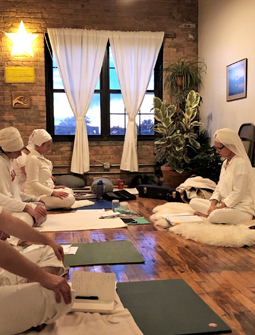
Sikh Dharma teaches that everything a person needs exists within himself or herself. We don’t need anything outside. We only need to touch the waters of Divinity that live within us. And by experiencing that place, life comes into a perfect balance.
The very best time of day to experience your Higher Self is during the hours before sunrise. This time of day is known as the Amrit Vela – the time of Deathless Consciousness. Generally, those hours are from 4 am to 7 am. During this time, the mind is calm enough that we can meditate deeply. Life around us is still. We can connect with our own Infinity before the hustle and bustle of the day begins.

The “bana” or form, the personal appearance of a Sikh, is one of the foremost ways that a Sikh maintains his or her consciousness as the Guru intended. The Guru has given the Sikh specific instructions to keep his or her natural form as created by God. Thus, all hair is maintained, uncut and untrimmed. The Guru has given the Sikh a standard of dress which distinguishes him or her as a human being dedicated to a life of truthful living.
The Guru has instructed Sikhs to maintain high moral character symbolized by the wearing of the steel bracelet, (“kara”) and to stand prepared to defend righteousness, wearing the “kirpan” or sword.
The long hair of a Sikh is tied up in a Rishi knot over the solar center and is covered with a turban, usually five meters of cotton cloth. (A man’s solar center is near the front of the head. A woman’s solar center is further back.) A female Sikh may also wear a chuni (chiffon scarf) draped over her turban.
The turban of a Sikh is his or her primary identifying feature. It is a statement of belonging to the Guru and it is a statement of the inner commitment of the one who wears it. The uncut hair and the turban are a declaration to live in accordance with, and if necessary, die in support of, the teachings of the Sikh Gurus and the Siri Guru Granth Sahib. Regardless of the circumstances or the type of employment or activity, a Sikh keeps his or her form and identity as a Sikh. Clothes are modest and exemplary of the identity and character of a soldier-saint.
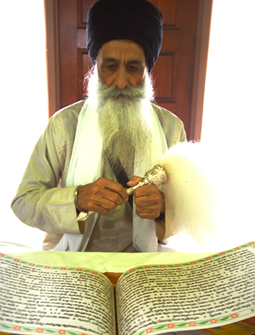
After the first Amrit Ceremony, Guru Gobind Singh gave the Khalsa a code by which to live their lives. A key part of that code includes the recitation of and meditation on certain Banis. Banis are Sacred Teachings Songs given by the Divine to the Sikh Masters.
Bani means vibration or frequency of consciousness. Bani is not just what the words say or what the language conveys in a literal or philosophical sense. Bani is given to those with a totally enlightened mind. It comes as a wholistic understanding, a revelation of Universal and Ultimate Truth. The Sikh Masters received these visions of sound. Then, they took that vibrational revelation and put it into words for the times in which they lived.
Guru Ram Das says . . .
“Baanee guroo guroo hai baanee Vich baanee amrit saaray. Gur baanee kehai sayvak jan maanaiPartakh guroo nistaaray.” “Bani is the Guru and Guru is the Bani. In the Bani are contained all the nectars. If the servant obeys whatever the Guru says,the Guru, in person, saves him.” – Siri Guru Granth Sahib, p. 982
Everything contained within the Siri Guru Granth Sahib is considered Bani. And Bani, itself, is the Guru. Bani is the Teacher, the Guide who takes us from the darkness of our own ego to the light of our Inner Divinity. How can a song be a Guru? How can sound lead us to liberation? It is actually quite simple.
When the tongue chants these Sacred Songs, it stimulates the meridians of the upper palate in a very specific pattern. If you run your tongue across the roof of your mouth, you will see how sensitive that part of your body is – and how it affects your entire nervous system. Gurbani is a Divine Sound Code that re-programs the brain, the glandular system and the nervous system. It re-programs us to see what the Masters saw. To experience what the Masters experienced. And, slowly, over time, as we integrate these visions and experiences, to live as the Masters lived.
“The Sound Current of the Shabad Guru is a perfect permutation to make us Divine. These Banis give us a sense of excellence. They create a permutation and combination between the tongue and the upper palate. This, in turn balances the hypothalamus so we can be great automatically. The hypothalamus controls habitual patterns. Reciting these Banis enables us to reset our patterns to experience Infinity. By reciting the Banis daily, by the Grace of God, we will begin to understand what the Guru is saying and we will begin to understand how it applies to our lives.”
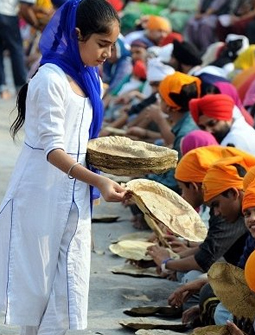
The practice of “Seva” must have originated with our most ancient human ancestors in their earliest acts of compassion, simply helping someone without regard for any compensation. This virtue has been embraced at the heart of Sikh Dharma as the highest expression of worship – serving the God within each human. It is the doing of the service that is important, not merely the feeling of compassion or empathy. In each moment of doing seva, a Sikh holds an inner intention of prayerful connection to the Divine – connection to the Divine present in the person who is being served; but also the connection to the Divine in all materials involved in the seva, like the food one may be distributing or the water being used to clean. In gurdwaras around the world, seva is pervasive in all activities. From the sweeping of floors, to the cooking of the langar, to the leading of the kirtan, Sikhs are encouraged and expected to participate in serving the needs of the gurdwara. But this expectation of serving extends beyond the needs of the congregation, into the surrounding community. At all times, the food prepared in the gurdwara kitchens is offered freely to anyone, Sikhs and non-Sikhs alike. At the most sacred of gurdwaras, the Harimandir Sahib (the Golden Temple) in Amritsar, India, over 100,000 people are served food every day. During times of natural disaster and suffering, Sikhs can often be seen at the forefront of relief efforts.
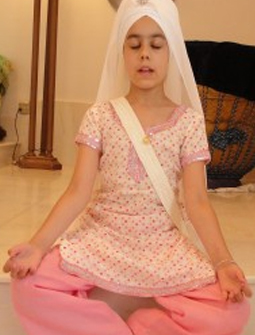
Perhaps one of Guru Nanak’s most important teachings was to use the power of Simran to transform and elevate consciousness. When we repeat a mantra or some lines of Gurbani, we are practicing Simran. Sometimes referred to as “Naam Simran” or “Naam Jappo”, this technology has it’s roots in ancient yogic teachings. It is a meditative practice that creates a powerful vibration or wave of sound or “Naad”. As we practice Simran, the “Naad” we are repeating overwhelms our inner dialog, which then brings a stillness (shuniya) to our mind. Practiced either aloud or silently, Simran shifts the mind away from negative thoughts and habits. When practiced deeply, Simran creates a feeling of majesty and divine alignment.
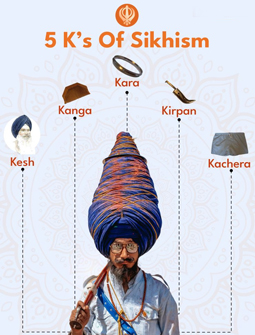
At the first Amrit ceremony, Guru Gobind Singh gave the Rehit, or self-discipline, which was recorded and passed down through the generations: The Rehit includes wearing the Five Kakar’s (5 K’s)
Kesh: uncut hair. A Khalsa does not cut or trim their hair. The hair is given by the Divine for a purpose so you keep it as it has been given to you.
Kangha: a wooden comb worn in the hair under the turban. It is worn as part of a commitment to keeping yourself and your physical world graceful and clean.
Kirpan: literally means “kindness.” The kirpan is a small sword. It is to be used only in self-defense or to protect those who are unable to defend themselves.
Kara: a steel or iron bangle worn on the left wrist for women and the right wrist for men. The Kara shows that you live as a slave to the Divine.
Kachhera: cotton shorts worn as a reminder and aid to keep the creative sexual energy in balance.
Read More About the 5 K’s: Wearing the 5 K’s (Kara, Kesh, Kirpan, Kachheras, Kanga)

The Gurdwara is “The Door to the Guru,” or “The Guru’s Gate.”
When we enter Gurdwara, we are in the actual Presence of our living Guru, the Siri Guru Granth Sahib. Siri Guru Granth Sahib is the embodiment of the Word, the Shabads, the Songs of worship and prayer of the Gurus. Guru Nanak, the first of the Sikh Gurus, received the Guruship from the Word of God, and transmitted It to all mankind. The Mantle of Guruship passed through ten bodies, until Guru Gobind Singh, the Tenth Master, compiled these sacred teachings into their present form, and gave the Guruship back to the Word of God, where it now resides, and will for all time. When we enter the Presence of the Guru, we do so with ultimate respect and humility. All that we think and say and do in the Presence of the Guru should reflect this attitude of gratitude and humility.
The key to all behavior in Gurdwara is grace. Whatever you do, maintain your grace. Gurdwara is a group meditation – please respect the devotion and the love of the other members of the Sadh Sangat, the Company of the Holy. They are in Gurdwara to experience the Guru, to receive His Blessing, and grow in consciousness. (An excerpt from “Victory & Virtue” published by Sikh Dharma International)
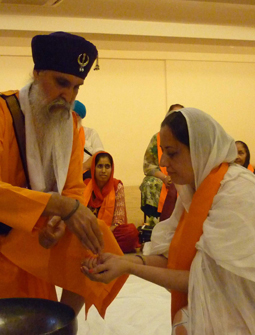
For many people, at some point in their spiritual development, they realize that they are already living their lives according to certain principles. They are at that stage of their personal and spiritual growth where they have made significant changes in their lifestyle and commitment to Self. Sikh vows and taking Amrit are a way to seal one’s inner commitment to oneself with the power of one’s word.
There are two levels of commitment in Sikh Dharma. They naturally evolve from one another.
Sikh Vows are simple statements of commitment, understanding, and self-discipline. With Sikh Vows, we surrender to the Shabad Guru as our Guide to spiritual awakening.
Sikh Vows provide a foundation of living a certain lifestyle to further develop and enhance your spiritual practice. The vows include not cutting your hair; refraining from consuming meat, alcohol and other stimulants; remaining celibate until married and maintaining a monogamous relationship with your spouse; and committing to meditation and prayer each day.
If you would like to find a Sikh Dharma International minister in your area to learn more about Sikh Vows, kindly contact Sarb Nam Kaur Khalsa at the Ministry Office: sdiministry@gmail.com.
Amrit: The Path of the Soldier Saint
The most powerful vows on the path of Sikh Dharma are known as Amrit. Amrit is often translated as “nectar” into English. But the root sounds of the word literally mean, “Deathless Blood.”
Amrit is a state of consciousness where a person knows in the very marrow of their bones that they are beyond the power of death; that the physical body and the mind are temporary – and that the eternal, undying Spirit within each one of us is who we truly are.
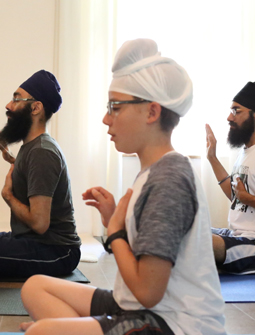
It is the Shabad Guru which unites us to the Infinite, through the meditation on the Siri Guru Granth Sahib. Kundalini Yoga prepares us to hear that Shabad.
Kundalini Yoga is the householders yoga. It is the Yoga of Awareness, of Chardi Kala. Guru Nanak admonished the yogis of his time that they were on the wrong path, teaching them that leaving their families, leaving this world and practicing austerities would not merge them with God. This is true. He did not teach that yoga itself is bad and in any way incongruent with the life of a Sikh. In fact, the internal process of merging with the Infinite that is described in the Siri Guru Granth Sahib is identical to universal principles of union with God which were taught by the ancient yogis.
A Sikh does not do yoga to “earn” his or her liberation. A Sikh uses the techniques of Kundalini Yoga in the same way that s/he would take a bath in the morning, or be conscious of how s/he maintains the body purely, eating a vegetarian diet, not partaking of tobacco or alcohol. In other words, a Sikh prepares this sacred body temple as purely as possible to bring the Holy Naam, the Holy Gurbani into it, to do justice to that Sacred Word. However, Kundalini Yoga prepares not only the physical body, but all of the Ten Bodies of which this magnificent human system is composed.